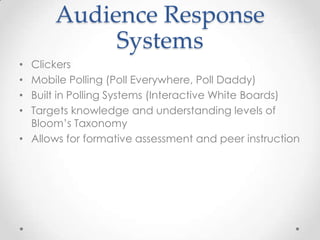Instructional Tech in English
- 1. Instructional Technology in the English Classroom Jeff Everhart Instructional Technology Trainer Digital Education Collaborative
- 3. Technology should be used to support objectives
- 5. Audience Response Systems Clickers Mobile Polling (Poll Everywhere, Poll Daddy) Built in Polling Systems (Interactive White Boards) Targets knowledge and understanding levels of BloomĪ»s Taxonomy ? Allows for formative assessment and peer instruction ? ? ? ?
- 7. Gamification and GamesBased Learning ? 77% of American households own a videogame system ? Average age of gamers: 37 years old ? 55% of gamers play on mobile devices
- 8. The Three Levels of Games ? Dynamics o By which rules does the player interact with the game? ? Mechanics o What is the point of the game? o What conditions need to be met for success? ? Aesthetics o Does this look and/or feel like a game? o Does it possess the conventions of a game? (ie. Levels, points, badges, etc.)
- 9. Oh, whatĪ»s in a game? ? Possesses game mechanics. In other words, governed by rules. ? Constant feedback ? Rewards at unpredictable intervals ? Some element of competition ? Some aspect of non-productivity (fun or play)
- 10. Gamification ? Application of game aesthetics to a non-game setting ? Examples include badges and leader points ? Typically used to increase motivation or engagement
- 11. Applications of Gamification ? Gamification has been widely applied in noneducational contexts ? Cash-back rewards ? Customer loyalty
- 12. So, what role can games play in education?
- 13. The Idea of Ī░▒╩▒¶▓╣▓ŌĪ▒
- 14. Games to Learn Content ? River City Project, Harvard University
- 15. Hero 1 ? Teaches English language skills to Arab students
- 16. Games to Learn Skills
- 17. Lumosity, cont.
- 18. Where to next?


















